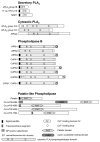Phospholipase A2 and phospholipase B activities in fungi
- PMID: 17081801
- PMCID: PMC2077850
- DOI: 10.1016/j.bbalip.2006.09.011
Phospholipase A2 and phospholipase B activities in fungi
Abstract
As saprophytes or disease causing microorganisms, fungi acquire nutrients from dead organic material or living host organisms. Lipids as structural components of cell membranes and storage compartments play an important role as energy-rich food source. In recent years, it also has become clear that lipids have a wide range of bioactive properties including signal transduction and cell to cell communication. Thus, it is not surprising that fungi possess a broad range of hydrolytic enzymes that attack neutral lipids and phospholipids. Especially during infection of a mammalian host, phospholipase A(2) (PLA(2)) enzymes released by fungi could play important roles not only for nutrient acquisition and tissue invasion, but for intricate modulation of the host's immune response. Sequencing of fungal genomes has revealed a wide range of genes encoding PLA(2) activities in fungi. We are just beginning to become aware of the significance these enzymes could have for the fungal cells and their interaction with the host.
Figures


References
Publication types
MeSH terms
Substances
Grants and funding
LinkOut - more resources
Full Text Sources
Other Literature Sources
Medical
Molecular Biology Databases
Research Materials

